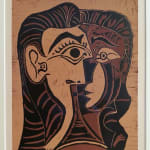Œuvres
Pablo Picasso Spanish, 1881-1973
Encadré 108 x 93 cm (42 ½ x 36 5/8 pouces)
Imprimé par Arnèra (Vallauris)
Picasso a commencé à travailler avec le linoleum en 1939, mais ce n’est qu’après sa rencontre avec Hidalgo Arnera à Vallauris, en 1952, que le médium est devenu un élément essentiel de la production de Picasso. Les connaissances et la disponibilité d'Arnera ont amené l'artiste à passer de longues heures à expérimenter cette nouvelle technique. Picasso a été graveur tout au cours de sa carrière, à partir de 1907, avec sa propre gravure. Cependant, il manquait toujours quelque chose dans le processus: la couleur. C'est pourquoi le linoléum est devenu une partie si importante de la dernière période de Picasso qu'il lui a donné la pièce manquante à ses multiples.
Entre 1959 et 1962, Picasso créera quatre-vingt-huit gravures au linoleum, selon une technique qu'il a lui-même inventée, lui permettant de continuer à utiliser la même matrice en appliquant progressivement différentes couleurs. Traditionnellement, une nouvelle plaque de linoléum devrait être utilisée pour chaque couleur désirée, mais Picasso sculpterait le support et appliquerait la couleur désirée sur une feuille lorsqu'il jugeait qu'un stade particulier était terminé. La matrice était ensuite nettoyée, sculptée à nouveau par l'artiste et appliquée avec une couleur différente. Ce nouveau processus était plus conforme à la rapidité d'exécution de Picasso. Nombre des œuvres créées au cours de cette période sont liées à la corrida et aux bacchanales, mais les œuvres les plus importantes de ces séries sont des portraits de femmes. Souvent inspirées par son amour et sa femme Jacqueline Roque, comme dans le cas de Portrait de Jacqueline de Face I, ces œuvres représentent, dans un style cubiste dont il s'inspire, un visage, simultanément montré de profil et de face, créant un équilibre unique. Les couleurs utilisées, souvent des tons de terre et de brun et beige, créent un parallèle direct avec la céramique créée à la même époque à Vallauris. Il en va de même pour les instruments utilisés pour la sculpture du linoléum, également utilisés dans la sculpture de la céramique.
Parmi les deux mille multiples que Picasso a produits au cours de sa carrière prolifique, le linoléum est devenu l’un des plus recherchés, avec seulement environ 150 œuvres créées avec cette technique. Le point culminant du médium a été atteint en 2014, lorsque le British Museum a acquis deux séries importantes de linoléum en 1962: Still Life under the Lamp et Jacqueline Reading. Les ensembles comprenaient une linoléographie finie et plusieurs démonstrations montrant leur évolution, étape par étape. "L'impact visuel, la rareté et la qualité exceptionnelle des ensembles de gravure sur linoléum de Picasso en font une acquisition fantastique pour le British Museum", a expliqué Stephen Deuchar, directeur du Art Fund, qui a contribué à l'achat.
La valeur des oeuvres varie en fonction du sujet, du format, du numéro d'édition, de la rareté, de l'origine et de la conservation générale de chaque œuvre. Les portraits de femmes et de natures mortes ont récemment gagné en popularité et sont devenus le point de référence des collectionneurs de linoléum. Les portraits de Jacqueline, ainsi que le Buste de femme d'après Cranach le Jeune, ont connu un intérêt croissant au cours des vingt dernières années et restent quelques-uns des chefs-d'œuvre créés par Picasso à l'aide de la coupe en linoleum.
Comme démontré dans l'exposition du Grand Palais, Picasso Mania, les techniques de gravures de l'artiste ont inspiré de nombreux artistes contemporains tels que Andy Warhol, Roy Lichtenstein, Richard Pettibone, Claes Oldenburg et Errò. Dans les années 80, Andy Warhol a créé une série d'œuvres d'après les têtes de Picasso, faisant écho aux linogravures de Jacqueline Roque.
Grâce à Picasso et à Warhol, les années 1960 ont vu les impressions modernes et contemporaines devenir un élément essentiel de la scène artistique. Warhol a choisi une approche plus traditionnelle de la production d’empreintes avec la création de sérigraphies. Il a ensuite suivi les traces de son homologue européen en immortalisant les femmes qu’il représentait. Sur la base de la culture pop et non de sa vie amoureuse personnelle, Warhol a créé des gravures de Marylin Monroe, Audrey Hepburn, Judy Garland, Brigitte Bardot, Elizabeth Taylor, etc.
Les deux artistes sont probablement devenus les imprimeurs les plus importants du siècle dernier et ont donné à la vie des nouveaux médias, en utilisant la couleur et en repoussant les limites d'une technique utilisée par de nombreux maîtres: Albrecht Dürer, Rembrandt, Goya, etc.
Le marché de l'art a suivi la tendance et a donné au média la reconnaissance qu'il mérite, dirigé par Picasso et Warhol, qui continuent d'obtenir des records d'enchères dans le monde entier pour l'impression de ventes dédiées.
Provenance
Galerie Alexander Kahan, New York
Collection privée, New York, 1990
Galerie Pace, New York, 2017
Collection privée, Paris
Expositions
Picasso, La Pièce à Musique de Mougins, Centre Culturel du Marais, Paris, 1982
Picasso Mania, Galerie Nationale du Grand Palais, Paris, 7 octobre 2015 - 29 février 2016
Literature
Catalogues
Publié: Galerie Louise Leiris, Paris
Catalogue raisonné: Bloch 1064; Baer 1278
Join our mailing list
* denotes required fields
We will process the personal data you have supplied in accordance with our privacy policy (available on request). You can unsubscribe or change your preferences at any time by clicking the link in our emails.



